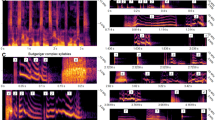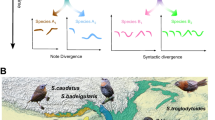Abstract
Language has a complex and hierarchical structure, which includes context-free grammar and phrase embedding. However, there have been no reports of a phrase-embedding structure in animal vocal communication, although there are several reports of combinational animal sounds that reference different objects and emotions. The songs of male Mueller’s gibbons in our study area consist of two notes, “wa” and “oo,” and combinations of these are flexible. There are various types of note orders in their song phrases. When the animals sing songs by combining acoustic elements flexibly, a complicated syntax may emerge. When phrase “N” is inserted within another phrase “AB,” the generated phrase is shown as “ANB.” We named this structure a phrase-inserting structure. If the phrase “N” itself has an inserting structure elsewhere, “ANB” is shown as “AABB.” This structure is considered a phrase-embedding structure, as defined by Abe and Watanabe (Nat Neurosci 14:1067–1074, 2011). We hypothesized that there is a phrase-inserting structure in male Mueller’s gibbons’ songs. We analyzed 70 songs by a single male and found note orders that suggested a phrase-inserting structure. Among them, there were four examples of phrases with structure within phrases, suggesting phrase embedding. Phrase inserting might be considered a sort of precursory level to recursion. Although our sample size was small, our results show that male Mueller’s gibbons may be able to produce recursive sequences. This provides an important insight into the study of language evolution.







Similar content being viewed by others
Change history
08 June 2020
In the original version of this article, the Supplementary materials i.e., ESM 1, ESM 2 and ESM 6 should have been part of the article and presented in the Appendix section.
References
Abe K, Watanabe D (2011) Songbirds possess the spontaneous ability to discriminate syntactic rules. Nat Neurosci 14:1067–1074
Arnold K, Zuberbühler K (2006) Language evolution: semantic combinations in primate calls. Nature 441:303
Beckers GJ, Bolhuis JJ, Okanoya K, Berwick RC (2012) Birdsong neurolinguistics: songbird context-free grammar claim is premature. Neuroreport 23(3):139–145
Beer C (1976) Some complexities in the communication behavior of gulls. Ann N Y Acad Sci 280:413–432
Berwick RC, Okanoya K, Beckers GJ, Bolhuis JJ (2011) Songs to syntax: the linguistics of birdsong. Trends Cogn Sci 15:113–121
Berwick RC, Beckers GJ, Okanoya K, Bolhuis JJ (2012) A bird’s eye view of human language evolution. Front Evol Neurosci 4:5
Biro D, Matsuzawa T (2001) Use of numerical symbols by the chimpanzee (Pan troglodytes): cardinals, ordinals, and the introduction of zero. Anim Cogn 4:193–200
Brockelman WY, Schilling D (1984) Inheritance of stereotyped gibbon calls. Nature 312:634–636
Chomsky N (2002) Syntactic structures, 9th edn. The Hague, The Netherlands: de Gruyter Mouton
Clarke E, Reichard UH, Zuberbühler K (2006) The syntax and meaning of wild gibbon songs. PLoS One 1:e73. https://doi.org/10.1371/journal.pone.0000073
Corballis MC (2007) Recursion, language, and starlings. Cogn Sci 31(4):697–704
Crockford C, Boesch C (2005) Call combinations in wild chimpanzees. Behaviour 142:397–421
Fitch WT (2010) Three meanings of “recursion”: key distinctions for biolinguistics. In: Larson RK, Deprez V, Yamakido H (eds) The evolution of human language: biolinguistic perspectives. Cambridge University Press, Cambridge, pp 73–90
Fitch WT, Friederici AD (2012) Artificial grammar learning meets formal language theory: an overview. Philos. Trans. R. Soc. Lond. B Biol Sci 367:1933–1955
Fitch WT, Hauser MD (2004) Computational constraints on syntactic processing in a nonhuman primate. Science 303:377–380
Friederici AD, Bahlmann J, Heim S, Schubotz RI, Anwander A (2006) The brain differentiates human and non-human grammars: functional localization and structural connectivity. Proc Natl Acad Sci U S A 103(7):2458–2463
Geissmann T (1984) Inheritance of song parameters in the gibbon song, analyzed in 2 hybrid gibbons (Hylobates pileatus × H. lar). Folia Primatol 42:216–235
Geissmann T, Bohlen-Eyring S, Heuck A (2005) The male song of the Javan silvery gibbon (Hylobates moloch). Contrib Zool 74:1–25
Gentner TQ, Fenn KM, Margoliash D, Nusbaum HC (2006) Recursive syntactic pattern learning by songbirds. Nature 440:1204–1207
Groves CP (1972) Systematics and phylogeny of gibbons. In Rumbaugh DM (ed): Gibbon and siamang, Basel Karger, vol 1, pp 1−89
Hailman JP, Ficken MS, Ficken RW (1985) The “chick-a-dee” calls of Parus atricapillus: a recombinant system of animal communication compared with written English. Semiotica 56:191–224
Haimoff EH (1985) The organization of song in Müeller’s gibbon (Hylobates muelleri). Int J Primatol 6:173–192
Hauser MD, Chomsky N, Fitch WT (2002) The faculty of language: what is it, who has it, and how did it evolve? Science 298:1569–1579
Hauser MD, Yang C, Berwick RC, Tattersall I, Ryan MJ, Watumull J, Chomsky N, Lewontin RC (2014) The mystery of language evolution. Front Psychol 5:401
Inoue S, Matsuzawa T (2007) Working memory of numerals in chimpanzees. Curr Biol 17(23):R1004–R1005
Inoue Y, Sinun W, Yosida S, Okanoya K (2013) Intergroup and intragroup antiphonal songs in wild male Mueller’s gibbons (Hylobates muelleri). Interact Stud 14:24–43
Inoue Y, Sinun W, Yosida S, Okanoya K (2017) Combinatory rules and chunk structure in male Mueller’s gibbon songs. Interact Stud 18:1–25
Jackendoff R, Pinker S (2005) The nature of the language faculty and its implications for evolution of language (reply to Fitch, Hauser, and Chomsky). Cogn 97(2):11–225
Kinsella A (2010) Was recursion the key step in the evolution of the human language faculty? In: Hulst H (ed) Recursion and human language. New York, NY, De Gruyter Mouton, pp 179–191
Marshall JT, Marshall ER (1976) Gibbons and their territorial songs. Science 193:235–237
Martins MD, Fitch WT (2014) Investigating recursion within a domain-specific framework. In: Lowenthal F, Lefebve L (eds) Language and recursion. Springer, New York, pp 15–26
Matsuzawa T (1985) Use of numbers by a chimpanzee. Nature 315:57–59
Mitani JC, Marler P (1989) A phonological analysis of male gibbon singing behavior. Behaviour 109:20–45
Ouattara K, Lemasson A, Zuberbühler K (2009) Campbell’s monkeys concatenate vocalizations into context-specific call sequences. Proc Natl Acad Sci U S A 106:22026–22031
Pietroski P, Crain S (2012) The language faculty. In: Margolis E, Samuels R, Stich SP (eds) The Oxford handbook of philosophy and cognitive science. Oxford University Press, New York, pp 361–381
Pinheiro JC, Bates DM (2000) Mixed-effects models in S and S-PLUS. Springer, New York
Pinheiro J, Bates D, DebRoy S, Sarkar D, R Core team (2019). nlme: linear and nonlinear mixed effects models. R package version 3.1-143. https://CRAN.R-project.org/package=nlme
Pinker S, Jackendoff R (2005) The faculty of language: what’s special about it? Cogn 95:201–236
R Core Team (2019) R: a language and environment for statistical computing. R Foundation for Statistical Computing, Vienna, Austria. https://www.R-project.org/
Raemaekers JJ, Raemaekers PM, Haimoff EH (1984) Loud calls of the gibbon (Hylobates lar): repertoire, organization and context. Behaviour 91:146–189
Rilling JK, Glasser MF, Preuss TM, Ma X, Zhao T, Hu X, Behrens TE (2008) The evolution of the arcuate fasciculus revealed with comparative DTI. Nat Neurosci 11:426–428
Robinson JG (1979) An analysis of the organization of vocal communication in the titi monkey Callicebus moloch. Z Tierpsychol 49:381–405
Robinson JG (1984) Syntactic structures in the vocalisations of wedge-capped capuchin monkeys, Cebus olivaceus. Behaviour 90:46–78
Ten Cate C, Okanoya K (2012) Revisiting the syntactic abilities of non-human animals: natural vocalizations and artificial grammar learning. Philos Trans R Soc Lond Ser B Biol Sci 367:1984–1994
Terleph TA, Malaivijitnond S, Reichard UH (2018) An analysis of white-handed gibbon male song reveals speech-like phrases. Am J Phys Anthropol 166:649–660
Thorpe WH (1961) Bird-song. The biology of vocal communication and expression in birds. Cambridge monographs in experimental biology no. 12. Cambridge: University Press
van Heijningen CA, De Visser J, Zuidema W, Ten Cate C (2009) Simple rules can explain discrimination of putative recursive syntactic structures by a songbird species. Proc Natl Acad Sci U S A 106:20538–20543
Zuberbühler K (2002) A syntactic rule in forest monkey communication. Anim Behav 63:293–299
Acknowledgments
We thank the Economic Planning Unit of the Malaysia Federal Government, the Economic Planning Unit of the Sabah State Government, Danum Valley Management Committee, and Sabah Biodiversity Centre for permission to conduct this study in Sabah. We also thank Donny Sah Itin, Isnadil Mohd, and Dennysius Aloysius, the nature guides at the BRL, for assistance with data collection and gibbon tracking. We are grateful to Etsuko Inoue for her dedicated help and advice with our research.
Funding
This research was partly supported by the Heisei Foundation for basic science.
Author information
Authors and Affiliations
Corresponding author
Ethics declarations
Conflict of interest
The authors declare that they have no conflict of interest.
Additional information
Publisher’s note
Springer Nature remains neutral with regard to jurisdictional claims in published maps and institutional affiliations.
The original version of this article was revised: The Supplementary materials i.e., ESM 1, ESM 2 and ESM 6 are now part of the article as Appendix.
Appendix
Appendix
Portion of the sonograms produced by 6 males around BRL. A: SAPA male, B: neighbor male located on the west side of the SAPA group, C: neighbor male located on the east side of the SAPA group, D: neighbor male located on the north side of the SAPA group, E: neighbor male located on the south side of the SAPA group. F: new group entered in the SAPA group territory after the SAPA group disappeared. In all songs, notes of “oo-wa” and “quaver-type notes” were not found. In D male song, the first and third phrases seem to have a phrase-inserting structure (solid line brackets show the inserted phrases)
Rights and permissions
About this article
Cite this article
Inoue, Y., Sinun, W., Yosida, S. et al. Note orders suggest phrase-inserting structure in male Mueller’s gibbon songs: a case study. acta ethol 23, 89–102 (2020). https://doi.org/10.1007/s10211-020-00341-y
Received:
Revised:
Accepted:
Published:
Issue Date:
DOI: https://doi.org/10.1007/s10211-020-00341-y






